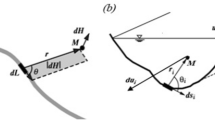Abstract
Stationary hydrological frequency analysis (SHFA) has been commonly employed for estimating the design flood in most countries. Fundamental to applying SHFA is the assumption that the data series is stationary. In theory it is not applicable if the series is non-stationary. In this paper, we propose a concept of Equivalent Reliability (ER) to estimate the design flood under non-stationary conditions, which considers the impact of design life period of an engineering on design flood. ER implies that regardless of environmental changes, the design reliability of engineering under non-stationary conditions should be identical with the planned design reliability specified at the stage of the engineering planning. ER is expected to solve two key questions: (i) to estimate the design flood with a given return period for an engineering to be constructed, and (ii) to adjust the original design flood of an already constructed engineering to obtain a new design flood for making the engineering adapt to the changing conditions. Two experiments are provided to demonstrate how to employ ER to solve the above two questions. In addition, an example of annual peak flow series was also used to illustrate ER. Results show that the design life poses a considerable impact on the estimation of design flood and the uncertainty of parameter estimations leads to a non-negligible uncertainty on the estimation of design flood. Overall, ER can be a potential method for estimation of design flood under non-stationary conditions.






Similar content being viewed by others
References
Burn DH, Hag Elnur MA (2002) Detection of hydrologic trends and variability. J Hydrol 255:107–122
Cooley D (2013) Return periods and return levels under climate change, in extremes in a changing climate: detection, analysis and uncertainty, edited by A. Agha Kouchak et al., Springer, Dordrecht
Du T, Xiong LH, Xu CY et al (2015) Return period and risk analysis of nonstationary low-flow series under climate change. J Hydrol 527:234–250
Hosking JRM, Wallis JR (1997) Regional Frequency Analysis. Cambridge University Press, New York
Hu YM, Liang ZM, Jiang XL et al (2015) Non-stationary hydrological frequency analysis based on the reconstruction of extreme hydrological series. Proc Int Assoc Proc Int Assoc Hydrol Sci 371:163
Hu YM, Liang ZM, Chen X et al (2017) Estimation of design flood using EWT and ENE metrics and uncertainty analysis under non-stationary conditions. Stoch Env Res Risk A. https://doi.org/10.1007/s00477-017-1404-1
Khaliq MN, Ouarda TBMJ, Ondo JC et al (2006) Frequency analysis of a sequence of dependent and/or non-stationary hydrometeorological observations: a review. J Hydrol 329(3):534–552
Li JZ, Tan SM (2015) Nonstationary flood frequency analysis for annual flood peak series, adopting climate indices and check dam index as covariates. Water Resour Manag 29(15):5533–5550
Liang ZM, Chang WJ, Li BQ (2012) Bayesian flood frequency analysis in the light of model and parameter uncertainties. Stoch Env Res Risk A 26:721–730
Liang ZM, Hu YM, Li BQ et al (2014) A modified weighted function method for parameter estimation of Pearson type three distribution. Water Resour Res 50(4):3216–3228
Liu DD, Guo SL, Lian YQ (2015) Climate-informed lowflow frequency analysis using nonstationary modelling. Hydrol Process 29(9):2112–2124
Lopez J, Frances F (2013) Non-stationary flood frequency analysis in continental Spanish rivers, using climate and reservoir indices as external covariates. Hydrol Earth Syst Sci 10(3):3103–3142
Milly PCD, Betancourt J, Falkenmark M et al (2009) Stationarity is dead: whither water management. Science 319:573–574
Montanari A, Koutsoyiannis D (2014) Modeling and mitigating natural hazards: Stationarity is immortal. Water Resour Res 50(12):9748–9756
Obeysekera J, Salas JD (2016) Frequency of recurrent extremes under Nonstationarity. J Hydrol Eng. https://doi.org/10.1061/(ASCE)HE.1943-5584.0001339
Olsen JR, Lambert JH, Haimes YY (1998) Risk of extreme events under nonstationary conditions. Risk Anal 18(4):497–510
Parey S, Hoang TTH, Dacunha-Castelle D (2010) Different ways to compute temperature return levels in the climate change context. Environmetrics 21:698–718
Read LK, Vogel RM (2015) Reliability, return periods, and risk under nonstationarity. Water Resour Res 51(8):6381–6398
Rootzen H, Katz RW (2013) Design life level: quantifying risk in a changing climate. Water Resour Res 49(9):5964–5972
Salas JD, Obeysekera J (2013) Revisiting the concepts of return period and risk for nonstationary hydrologic extreme events. J Hydrol Eng 19(3):554–568
Strupczewski WG, Singh VP, Feluch W (2001) Non-stationary approach to at-site flood frequency modeling I. Maximum likelihood estimation. J Hydrol 248:123–142
Vasiliades L, Galiatsatou P, Loukas A (2015) Nonstationary frequency analysis of annual maximum rainfall using climate covariates. Water Resour Manag 29(2):339–358
Volpi E, Fiori A, Grimaldi S et al (2015) One hundred years of return period: strengths and limitations. Water Resour Res 51(10):8570–8585
Wigley TML (1988) The effect of climate change on the frequency of absolute extreme events. Clim Monit 17(1–2):44–55
Xiong L, Du T, Xu CY et al (2015) Non-stationary annual maximum flood frequency analysis using the norming constants method to consider non-stationarity in the annual daily flow series. Water Resour Manag 29(10):3615–3633
Zhang XB, Zwiers FW, Hegerl GC et al (2007) Detection of human influence on twentieth-century precipitation trends. Nature 448(7152):461–465
Zhang XB, Wang J, Zwiers FW et al (2010) The influence of large-scale climate variability on winter maximum daily precipitation over North America. J Clim 23(11):2902–2915
Acknowledgments
This study was supported by the National Natural Science Foundation of China (41730750, 51709073), the Natural Science Foundation of Jiangsu Province (BK20170878), Fundamental Research Funds for the Central Universities of China (2017B17414), and Postdoctoral Science Foundation of Jiangsu Province (1701088B). We are also grateful to the editor and all anonymous reviewers for their helpful comments, which helped us to improve the quality of the article.
Author information
Authors and Affiliations
Corresponding author
Rights and permissions
About this article
Cite this article
Hu, Y., Liang, Z., Singh, V.P. et al. Concept of Equivalent Reliability for Estimating the Design Flood under Non-stationary Conditions. Water Resour Manage 32, 997–1011 (2018). https://doi.org/10.1007/s11269-017-1851-y
Received:
Accepted:
Published:
Issue Date:
DOI: https://doi.org/10.1007/s11269-017-1851-y




